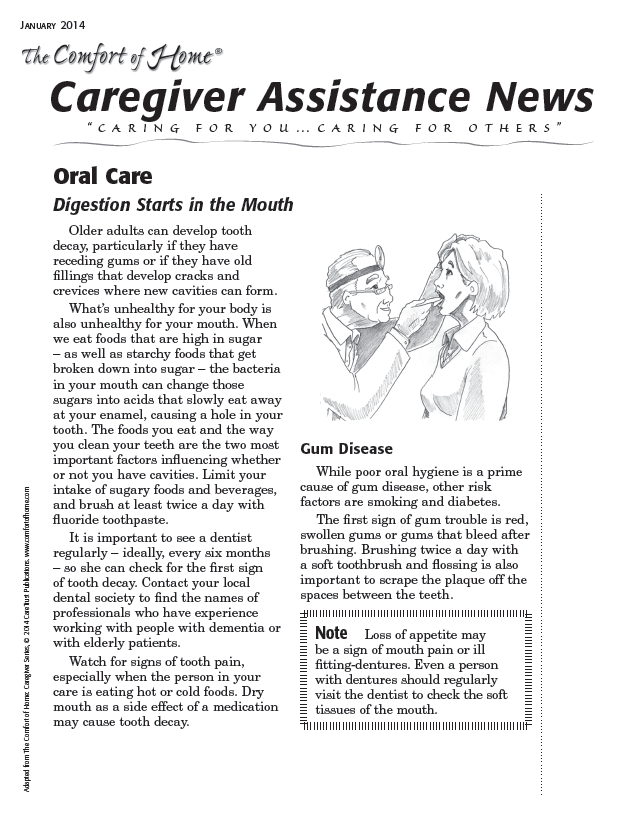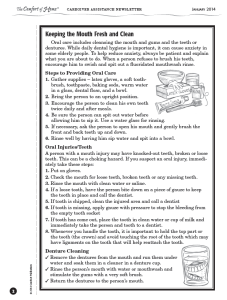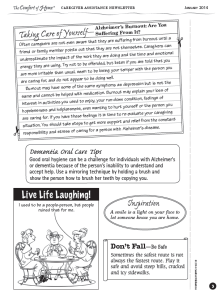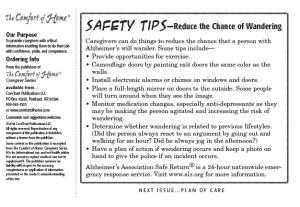Caregiver Assistance News
“CARING FOR YOU…CARING FOR OTHERS”
Adapted from The Comfort of Home: Caregiver Series, © 2014 CareTrust Publications. www.comfortofhome.com
JANUARY 2014
Gum Disease
While poor oral hygiene is a prime
cause of gum disease, other risk
factors are smoking and diabetes.
The fi rst sign of gum trouble is red,
swollen gums or gums that bleed after
brushing. Brushing twice a day with
a soft toothbrush and fl ossing is also
important to scrape the plaque off the
spaces between the teeth.
Older adults can develop tooth
decay, particularly if they have
receding gums or if they have old
fi llings that develop cracks and
crevices where new cavities can form.
What’s unhealthy for your body is
also unhealthy for your mouth. When
we eat foods that are high in sugar
– as well as starchy foods that get
broken down into sugar – the bacteria
in your mouth can change those
sugars into acids that slowly eat away
at your enamel, causing a hole in your
tooth. The foods you eat and the way
you clean your teeth are the two most
important factors infl uencing whether
or not you have cavities. Limit your
intake of sugary foods and beverages,
and brush at least twice a day with
fl uoride toothpaste.
It is important to see a dentist
regularly – ideally, every six months
– so she can check for the fi rst sign
of tooth decay. Contact your local
dental society to fi nd the names of
professionals who have experience
working with people with dementia or
with elderly patients.
Watch for signs of tooth pain,
especially when the person in your
care is eating hot or cold foods. Dry
mouth as a side effect of a medication
may cause tooth decay.
Oral Care
Digestion Starts in the Mouth
Note Loss of appetite may
be a sign of mouth pain or ill
fi tting-dentures. Even a person
with dentures should regularly
visit the dentist to check the soft
tissues of the mouth.2
© 2014 CareTrust Publications
CAREGIVER ASSISTANCE NEWSLETTER JANUARY 2014
Keeping the Mouth Fresh and Clean
Oral care includes cleansing the mouth and gums and the teeth or
dentures. While daily dental hygiene is important, it can cause anxiety in
some elderly people. To help reduce anxiety, always be patient and explain
what you are about to do. When a person refuses to brush his teeth,
encourage him to swish and spit out a fl uoridated mouthwash rinse.
Steps to Providing Oral Care
1. Gather supplies – latex gloves, a soft toothbrush,
toothpaste, baking soda, warm water
in a glass, dental fl oss, and a bowl.
2. Bring the person to an upright position.
3. Encourage the person to clean his own teeth
twice daily and after meals.
4. Be sure the person can spit out water before
allowing him to sip it. Use a water glass for rinsing.
5. If necessary, ask the person to open his mouth and gently brush the
front and back teeth up and down.
6. Rinse well by having him sip water and spit into a bowl.
Oral Injuries/Teeth
A person with a mouth injury may have knocked-out teeth, broken or loose
teeth. This can be a choking hazard. If you suspect an oral injury, immediately
take these steps:
1. Put on gloves.
2. Check the mouth for loose teeth, broken teeth or any missing teeth.
3. Rinse the mouth with clean water or saline.
4. If a loose tooth, have the person bite down on a piece of gauze to keep
the tooth in place and call the dentist.
5. If tooth is chipped, clean the injured area and call a dentist
6. If tooth is missing, apply gauze with pressure to stop the bleeding from
the empty tooth socket
7. If tooth has come out, place the tooth in clean water or cup of milk and
immediately take the person and tooth to a dentist.
8. Whenever you handle the tooth, it is important to hold the top part or
the tooth (the crown) and avoid touching the root of the tooth which may
have ligaments on the tooth that will help reattach the tooth.
Denture Cleaning
✓ Remove the dentures from the mouth and run them under
water and soak them in a cleaner in a denture cup.
✓ Rinse the person’s mouth with water or mouthwash and
stimulate the gums with a very soft brush.
✓ Return the dentures to the person’s mouth.3
© 2014 CareTrust Publications
CAREGIVER ASSISTANCE NEWSLETTER JANUARY 2014
Don’t Fall—Be Safe
Sometimes the safest route is not
always the fastest route. Play it
safe and avoid steep hills, cracked
and icy sidewalks.
Inspiration
A smile is a light on your face to
let someone know you are home.
Taking Care of Yourself—
Often caregivers are not even aware that they are suffering from burnout until a
friend or family member points out that they are not themselves. Caregivers can
underestimate the impact of the work they are doing and the time and emotional
energy they are using. Try not to be offended, but listen if you are told that you
are more irritable than usual, seem to be losing your temper with the person you
are caring for, and do not appear to be doing well.
Burnout may have some of the same symptoms as depression but is not the
same and cannot be helped with medication. Burnout may explain your loss of
interest in activities you used to enjoy, your run-down condition, feelings of
hopelessness and helplessness, even wanting to hurt yourself or the person you
are caring for. If you have these feelings it is time to re-evaluate your caregiving
situation. You should take steps to get more support and relief from the constant
responsibility and stress of caring for a person with Alzheimer’s disease.
Alzheimer’s Burnout: Are You
Suffering From It?
Dementia Oral Care Tips
Good oral hygiene can be a challenge for individuals with Alzheimer’s
or dementia because of the person’s inability to understand and
accept help. Use a mirroring technique by holding a brush and
show the person how to brush her teeth by copying you.
Live Life Laughing!
I used to be a people-person, but people
ruined that for me.Our Purpose
To provide caregivers with critical
information enabling them to do their job
with confi dence, pride, and competence.
Ordering Info
From the publishers of
Caregiver Series
available from…
CareTrust Publications LLC
PO Box 10283, Portland, OR 97296
800-565-1533
or www.comfortofhome.com
Comments and suggestions welcome.
©2014 CareTrust Publications LLC.
All rights reserved. Reproduction of any
component of this publication is forbidden
without a license from the publisher.
Some content in this publication is excerpted
from The Comfort of Home: Caregivers Series.
It is for informational use and not health advice.
It is not meant to replace medical care but to
supplement it. The publisher assumes no
liability with respect to the accuracy,
completeness or application of information
presented or the reader’s misunderstanding
of the text.
NEXT ISSUE…PLAN OF CARE
Safety Tips—
Caregivers can do things to reduce the chance that a person with
Alzheimer’s will wander. Some tips include—
• Provide opportunities for exercise.
• Camoufl age doors by painting exit doors the same color as the
walls.
• Install electronic alarms or chimes on windows and doors.
• Place a full-length mirror on doors to the outside. Some people
will turn around when they see the image.
• Monitor medication changes, especially anti-depressants as they
may be making the person agitated and increasing the risk of
wandering.
• Determine whether wandering is related to previous lifestyles.
(Did the person always react to an argument by going out and
walking for an hour? Did he always jog in the afternoon?)
• Have a plan of action if wandering occurs and keep a photo on
hand to give the police if an incident occurs.
Alzheimer’s Association Safe Return® is a 24-hour nationwide emergency
response service. Visit www.alz.org for more information.
Reduce the Chance of Wandering Caregiver Assistance News
“ C ARING FOR YOU … CARING FOR OTHERS ”
© 2014 CareTrust Publications
ORAL CARE—JANUARY 2014
Name _______________________________________________________________________
Signature _____________________________________ Date _________________________
KEY: 1. T; 2. T; 3. F; 4. F; 5. T; 6. T; 7. T; 8. T; 9. T; 10. T
QUICK QUIZ
More than half of all people in the United States don’t see a dentist for regular
dental care, and the main reason is fear of dentists. The more a person avoids the
dentist offi ce, the more problems are likely to develop and the more extensive—and
expensive—any dental work will be. Read the issue and answer True or False to the
questions below.
1. What’s unhealthy for your body is also unhealthy for your mouth.
T F
2. The foods you eat and the way you clean your teeth are the two most important
factors infl uencing whether or not you have cavities.
T F
3. Eating hot or cold foods do not cause tooth pain.
T F
4. Smoking and diabetes do not cause gum disease.
T F
5. Dental hygiene can cause anxiety in some elderly people.
T F
6. The fi rst sign of gum trouble is red, swollen gums or gums that bleed after
brushing.
T F
7. A broken or loose tooth can be a choking hazard.
T F
8. Good oral hygiene can be a challenge for individuals with Alzheimer’s or dementia
because of the person’s inability to understand and accept help.
T F
9. When we eat foods that are high in sugar – as well as starchy foods that get
b roken down into sugar – the bacteria in your mouth can change those sugars
into acids that slowly eat away at the enamel, causing a hole in your tooth.
T F
10. Older adults can develop tooth decay, particularly if they have receding gums or
if they have old fi llings that develop cracks and crevices where new cavities can form.
T F
“CARING FOR YOU…CARING FOR OTHERS”
Adapted from The Comfort of Home: Caregiver Series, © 2014 CareTrust Publications. www.comfortofhome.com
JANUARY 2014
Gum Disease
While poor oral hygiene is a prime
cause of gum disease, other risk
factors are smoking and diabetes.
The fi rst sign of gum trouble is red,
swollen gums or gums that bleed after
brushing. Brushing twice a day with
a soft toothbrush and fl ossing is also
important to scrape the plaque off the
spaces between the teeth.
Older adults can develop tooth
decay, particularly if they have
receding gums or if they have old
fi llings that develop cracks and
crevices where new cavities can form.
What’s unhealthy for your body is
also unhealthy for your mouth. When
we eat foods that are high in sugar
– as well as starchy foods that get
broken down into sugar – the bacteria
in your mouth can change those
sugars into acids that slowly eat away
at your enamel, causing a hole in your
tooth. The foods you eat and the way
you clean your teeth are the two most
important factors infl uencing whether
or not you have cavities. Limit your
intake of sugary foods and beverages,
and brush at least twice a day with
fl uoride toothpaste.
It is important to see a dentist
regularly – ideally, every six months
– so she can check for the fi rst sign
of tooth decay. Contact your local
dental society to fi nd the names of
professionals who have experience
working with people with dementia or
with elderly patients.
Watch for signs of tooth pain,
especially when the person in your
care is eating hot or cold foods. Dry
mouth as a side effect of a medication
may cause tooth decay.
Oral Care
Digestion Starts in the Mouth
Note Loss of appetite may
be a sign of mouth pain or ill
fi tting-dentures. Even a person
with dentures should regularly
visit the dentist to check the soft
tissues of the mouth.2
© 2014 CareTrust Publications
CAREGIVER ASSISTANCE NEWSLETTER JANUARY 2014
Keeping the Mouth Fresh and Clean
Oral care includes cleansing the mouth and gums and the teeth or
dentures. While daily dental hygiene is important, it can cause anxiety in
some elderly people. To help reduce anxiety, always be patient and explain
what you are about to do. When a person refuses to brush his teeth,
encourage him to swish and spit out a fl uoridated mouthwash rinse.
Steps to Providing Oral Care
1. Gather supplies – latex gloves, a soft toothbrush,
toothpaste, baking soda, warm water
in a glass, dental fl oss, and a bowl.
2. Bring the person to an upright position.
3. Encourage the person to clean his own teeth
twice daily and after meals.
4. Be sure the person can spit out water before
allowing him to sip it. Use a water glass for rinsing.
5. If necessary, ask the person to open his mouth and gently brush the
front and back teeth up and down.
6. Rinse well by having him sip water and spit into a bowl.
Oral Injuries/Teeth
A person with a mouth injury may have knocked-out teeth, broken or loose
teeth. This can be a choking hazard. If you suspect an oral injury, immediately
take these steps:
1. Put on gloves.
2. Check the mouth for loose teeth, broken teeth or any missing teeth.
3. Rinse the mouth with clean water or saline.
4. If a loose tooth, have the person bite down on a piece of gauze to keep
the tooth in place and call the dentist.
5. If tooth is chipped, clean the injured area and call a dentist
6. If tooth is missing, apply gauze with pressure to stop the bleeding from
the empty tooth socket
7. If tooth has come out, place the tooth in clean water or cup of milk and
immediately take the person and tooth to a dentist.
8. Whenever you handle the tooth, it is important to hold the top part or
the tooth (the crown) and avoid touching the root of the tooth which may
have ligaments on the tooth that will help reattach the tooth.
Denture Cleaning
✓ Remove the dentures from the mouth and run them under
water and soak them in a cleaner in a denture cup.
✓ Rinse the person’s mouth with water or mouthwash and
stimulate the gums with a very soft brush.
✓ Return the dentures to the person’s mouth.3
© 2014 CareTrust Publications
CAREGIVER ASSISTANCE NEWSLETTER JANUARY 2014
Don’t Fall—Be Safe
Sometimes the safest route is not
always the fastest route. Play it
safe and avoid steep hills, cracked
and icy sidewalks.
Inspiration
A smile is a light on your face to
let someone know you are home.
Taking Care of Yourself—
Often caregivers are not even aware that they are suffering from burnout until a
friend or family member points out that they are not themselves. Caregivers can
underestimate the impact of the work they are doing and the time and emotional
energy they are using. Try not to be offended, but listen if you are told that you
are more irritable than usual, seem to be losing your temper with the person you
are caring for, and do not appear to be doing well.
Burnout may have some of the same symptoms as depression but is not the
same and cannot be helped with medication. Burnout may explain your loss of
interest in activities you used to enjoy, your run-down condition, feelings of
hopelessness and helplessness, even wanting to hurt yourself or the person you
are caring for. If you have these feelings it is time to re-evaluate your caregiving
situation. You should take steps to get more support and relief from the constant
responsibility and stress of caring for a person with Alzheimer’s disease.
Alzheimer’s Burnout: Are You
Suffering From It?
Dementia Oral Care Tips
Good oral hygiene can be a challenge for individuals with Alzheimer’s
or dementia because of the person’s inability to understand and
accept help. Use a mirroring technique by holding a brush and
show the person how to brush her teeth by copying you.
Live Life Laughing!
I used to be a people-person, but people
ruined that for me.Our Purpose
To provide caregivers with critical
information enabling them to do their job
with confi dence, pride, and competence.
Ordering Info
From the publishers of
Caregiver Series
available from…
CareTrust Publications LLC
PO Box 10283, Portland, OR 97296
800-565-1533
or www.comfortofhome.com
Comments and suggestions welcome.
©2014 CareTrust Publications LLC.
All rights reserved. Reproduction of any
component of this publication is forbidden
without a license from the publisher.
Some content in this publication is excerpted
from The Comfort of Home: Caregivers Series.
It is for informational use and not health advice.
It is not meant to replace medical care but to
supplement it. The publisher assumes no
liability with respect to the accuracy,
completeness or application of information
presented or the reader’s misunderstanding
of the text.
NEXT ISSUE…PLAN OF CARE
Safety Tips—
Caregivers can do things to reduce the chance that a person with
Alzheimer’s will wander. Some tips include—
• Provide opportunities for exercise.
• Camoufl age doors by painting exit doors the same color as the
walls.
• Install electronic alarms or chimes on windows and doors.
• Place a full-length mirror on doors to the outside. Some people
will turn around when they see the image.
• Monitor medication changes, especially anti-depressants as they
may be making the person agitated and increasing the risk of
wandering.
• Determine whether wandering is related to previous lifestyles.
(Did the person always react to an argument by going out and
walking for an hour? Did he always jog in the afternoon?)
• Have a plan of action if wandering occurs and keep a photo on
hand to give the police if an incident occurs.
Alzheimer’s Association Safe Return® is a 24-hour nationwide emergency
response service. Visit www.alz.org for more information.
Reduce the Chance of Wandering Caregiver Assistance News
“ C ARING FOR YOU … CARING FOR OTHERS ”
© 2014 CareTrust Publications
ORAL CARE—JANUARY 2014
Name _______________________________________________________________________
Signature _____________________________________ Date _________________________
KEY: 1. T; 2. T; 3. F; 4. F; 5. T; 6. T; 7. T; 8. T; 9. T; 10. T
QUICK QUIZ
More than half of all people in the United States don’t see a dentist for regular
dental care, and the main reason is fear of dentists. The more a person avoids the
dentist offi ce, the more problems are likely to develop and the more extensive—and
expensive—any dental work will be. Read the issue and answer True or False to the
questions below.
1. What’s unhealthy for your body is also unhealthy for your mouth.
T F
2. The foods you eat and the way you clean your teeth are the two most important
factors infl uencing whether or not you have cavities.
T F
3. Eating hot or cold foods do not cause tooth pain.
T F
4. Smoking and diabetes do not cause gum disease.
T F
5. Dental hygiene can cause anxiety in some elderly people.
T F
6. The fi rst sign of gum trouble is red, swollen gums or gums that bleed after
brushing.
T F
7. A broken or loose tooth can be a choking hazard.
T F
8. Good oral hygiene can be a challenge for individuals with Alzheimer’s or dementia
because of the person’s inability to understand and accept help.
T F
9. When we eat foods that are high in sugar – as well as starchy foods that get
b roken down into sugar – the bacteria in your mouth can change those sugars
into acids that slowly eat away at the enamel, causing a hole in your tooth.
T F
10. Older adults can develop tooth decay, particularly if they have receding gums or
if they have old fi llings that develop cracks and crevices where new cavities can form.
T F




